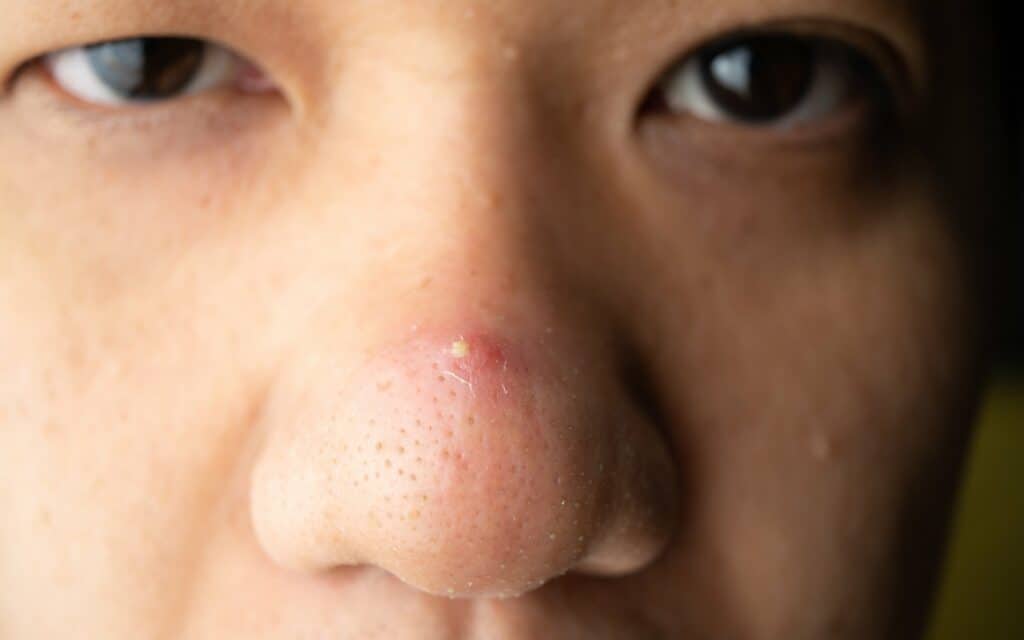If you’ve ever struggled with blemishes, you’re likely familiar with the term “whiteheads.” They’re a type of acne that can appear anywhere on your face, but they’re particularly common on the nose. In this article, we will explore what whiteheads on the nose are, why they occur, what causes them, and how to effectively treat and prevent them.
What are Whiteheads?
Whiteheads are small, closed pores filled with oil, dead skin cells, and bacteria. They’re named for the white or yellowish head that appears at the top of the pore. Unlike blackheads, which are open and oxidized, whiteheads are covered by a thin layer of skin that seals the pore, giving them their white appearance.
Why on the Nose?
The nose, as part of the T-zone (the forehead, nose, and chin), is notorious for its high concentration of oil-producing glands. This makes it a common site for various types of acne, including whiteheads.
What Causes Whiteheads on Nose?
Whiteheads on the nose are primarily caused by excessive sebum production, dead skin cells, and bacteria. When the pore becomes clogged with this mixture, a whitehead forms. This can be exacerbated by hormonal changes, stress, poor diet, and certain medications. Not thoroughly removing makeup or using heavy, comedogenic products can also contribute to the development of whiteheads.
Over-the-Counter Treatments
When it comes to treating whiteheads on the nose, several over-the-counter (OTC) options can be effective. These often contain active ingredients like:
1.Benzoyl Peroxide: This has antibacterial properties that kill acne-causing bacteria.
2.Salicylic Acid: This acts as a chemical exfoliant to unclog pores and reduce inflammation.
3.Retinoids: These promote rapid cell turnover, helping to prevent cells from blocking pores.
Remember to start with a lower concentration and gradually increase as your skin builds tolerance, as these ingredients can cause dryness and skin irritation.
At-Home Treatments: Convenient and Effective
If you prefer home remedies or want to complement your OTC treatments, consider the following tips:
1.Consistent Skincare Routine: Cleanse your face gently twice a day to remove excess oil and dirt. Don’t forget to moisturize, as this can actually help regulate oil production.
2.Regular Exfoliation: Use a mild exfoliant once or twice a week to remove dead skin cells that can clog pores.
3.Clay Masks: These can help draw out excess oil and impurities from your skin. Look for products with kaolin or bentonite clay.
4.Non-Comedogenic Products: Use makeup and skincare products labeled “non-comedogenic,” which means they won’t clog your pores.
5.Tea Tree Oil: Known for its antibacterial properties, tea tree oil can be an effective spot treatment for whiteheads. However, it’s potent, so always dilute it with a carrier oil.
6.Warm Compress: A warm compress can help soften the oils blocking the pore, making the whitehead easier to treat.
As with any treatment, what works best will depend on your specific skin type and needs. Always do a patch test when trying new products to avoid potential skin irritation.
Preventing Whiteheads on Nose
Prevention is often the best treatment. Keeping your skin clean, regularly exfoliating to remove dead skin cells, and avoiding oil-based makeup or skincare products can help prevent whiteheads on the nose. Additionally, maintaining a balanced diet, staying hydrated, and managing stress can support overall skin health and reduce the likelihood of breakouts.
Conclusion
Whiteheads on the nose can be a pesky problem, but with the right knowledge and skincare practices, they can be effectively managed. If over-the-counter and at-home treatments aren’t helping, consider consulting a dermatologist for professional advice and treatment options. Remember, everyone’s skin is different, and what works for one person may not work for another.
